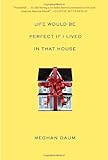Life Would Be Perfect If I Lived In That House, Meghan Daum
 As a member of the recently lamented “slow-to-grow-up” generation of young adults, Meghan Daum has spent her fair share of years living in spare rooms, shared apartments, and rented spaces. But unlike some of her generation, she longs to settle down with property and a house, and so spends the better part of two hundred pages chronicling her journey. At first, Daum is a sympathetic narrator — she describes her childhood games of playing house, pretending to live a frontier life like Laura Ingalls Wilder, and her parents longing to live in in New York, going so far as to claim to be from NYC despite living twenty miles away in New Jersey. When she goes away to college, choosing Vassar in the hopes of finding the means after graduation to a “shabby yet elegant prewar apartment in Manhattan,” she spends her time dorm-hopping or planning her next move. Astonishingly, after graduation, she manages to, with two of her friends, find said apartment; over the next five years, she goes through seven roommates, and finally “as I grew older and the roommate turnover rate grew higher , the place felt less like a source of emotional and aesthetic ballast than a crash pad I’d mistaken for a permanent resident. Worse, as my cohabitants became younger, my ‘senior roommate’ status began to feel less like a mark of distinction than a big-city version of being a college student who can’t bring himself to graduate even though he’s approaching thirty.” This flowery and dramatic language continues throughout the rest of the narrative, including Daum’s on-again off-again flirtation with the idea of a farm in Nebraska, subletting a condo in Hollywood from a despised woman whose faults include too many cats and candles, her despair over the housing market, and her desperation to appear as an independent, worldly woman who owns a home.
As a member of the recently lamented “slow-to-grow-up” generation of young adults, Meghan Daum has spent her fair share of years living in spare rooms, shared apartments, and rented spaces. But unlike some of her generation, she longs to settle down with property and a house, and so spends the better part of two hundred pages chronicling her journey. At first, Daum is a sympathetic narrator — she describes her childhood games of playing house, pretending to live a frontier life like Laura Ingalls Wilder, and her parents longing to live in in New York, going so far as to claim to be from NYC despite living twenty miles away in New Jersey. When she goes away to college, choosing Vassar in the hopes of finding the means after graduation to a “shabby yet elegant prewar apartment in Manhattan,” she spends her time dorm-hopping or planning her next move. Astonishingly, after graduation, she manages to, with two of her friends, find said apartment; over the next five years, she goes through seven roommates, and finally “as I grew older and the roommate turnover rate grew higher , the place felt less like a source of emotional and aesthetic ballast than a crash pad I’d mistaken for a permanent resident. Worse, as my cohabitants became younger, my ‘senior roommate’ status began to feel less like a mark of distinction than a big-city version of being a college student who can’t bring himself to graduate even though he’s approaching thirty.” This flowery and dramatic language continues throughout the rest of the narrative, including Daum’s on-again off-again flirtation with the idea of a farm in Nebraska, subletting a condo in Hollywood from a despised woman whose faults include too many cats and candles, her despair over the housing market, and her desperation to appear as an independent, worldly woman who owns a home.
Although the book begins well, Daum’s pathos and constant equating her self with her prospects of home ownership grates after a few chapters. By the end, when she has finally purchased a home and is negotiating sharing the space with her new boyfriend, readers will be exhausted as she continues to moon over other houses and will be glad to get to the pat “home is where the heart is” conclusion. There is plenty to be said about the search for home, about today’s young adults and their delayed settlement into a house, but this book wanders and wonders too much to significantly address these topics.